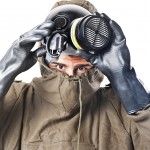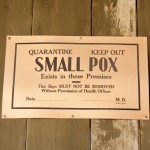I was glancing through The Wall Street Journal. this morning (that period is intentional as I found out recently in their 150th anniversary issue) and saw an article about smallpox, that old enemy of mankind. The CDC issued a media statement saying six vials labeled with the technical name of the disease, variola, had been found in an old storage room belonging to an FDA lab that is on the NIH Bethesda, Maryland facility. Forty-two years ago the FDA took over that lab, among others, and only now were those labs being moved to the main FDA location in the DC area. The vials themselves date back ~60 years and now will be tested to see if the material in them is viable (i.e., live smallpox viruses).
I reviewed the CDC's Bio-hazard Safety Levels; they range from 1 to 4 with more serious infectious agents occupying the higher levels. A BSL-3 agent can cause serious or deadly disease, but either doesn't spread from person to person (at least not easily) and/or has a preventive or treatment known. Plague, rabies virus and West Nile fit into this category. Smallpox is obviously a BSL-4 bug, the most dangerous kind and in the company of Ebola virus. A February 15, 2012 Reuters article, "How secure are labs handling the world's deadliest pathogens?" talked about the precautions used in such a lab in Galveston, Texas. The boss there got entry by swiping a key card, was scanned by 100+ closed-circuit cameras as he opened seven additional locked doors before he reached the lab where another card swipe and a fingerprint scan were necessary for entry. The Washington Post article on the recently found vials has a six-minute video on BSL-4 procedures with a comment that there are three over-lapping types of safety precautions: those for containment of the hazardous material; those for personal protection and overall administrative factors.
The air flow and exhaust systems used in Galveston, the full-body suits with their own air supply and the intruder drills that are conducted all made me somewhat more comfortable. But that's in a government-funded laboratory. Even in the United States, a private-funded lab may not be subject to the same rules and regulations, Elsewhere the procedures that must be followed vary. In 2011 there were 24 known BSL-4 labs in the world with six in the U.S. (The GAO said we had considerably more.) In 2013 there was considerable protest in Boston over the proposed BSL-3 and BSL-4 lab there.
I've written about smallpox before, but a brief history, available online on a dermatology website was worth reviewing. The disease likely originated in Africa about 12,000 years ago. caused a major epidemic during an Egyptian-Hittite war in 1,350 B.C.E and left typical scars on the mummy of Pharaoh Ramses V who died in 1157 B.C.E. It got to Europe somewhere between the 5th and 7th centuries C.E.; millions died in Europe and the Western Hemisphere before Edward Jenner developed vaccination in 1796. The term came from the Latin word for cow (vaca), as Jenner used fluid from a cowpox-infected dairymaid's hand to inoculate an eight-year-old boy. In 1967 WHO estimated there were 15 million cases of smallpox and 2 million deaths from the disease. Total smallpox deaths over the past 12,000 years have been estimated at 300-500 million, more than all the world wars combined.
By 1980 the World Health Organization declared the globe smallpox-free. In this country, we quit vaccinating the general population in 1972 and stopped giving the inoculation to new military personnel in 1990.
My wife's old shot record shows she got her first vaccination against small pox in 1956 and the last booster in 1980. We were both assigned to bases in the Far East in the early and mid 80s. I can't find my military vaccination record from that time frame, but logically wouldn't have had a booster after 1986 when I got back to a base in Texas. Since immunity is unlikely to last more than ten years, at this stage we'd both be vulnerable to smallpox, like most everyone else.
The only known supplies of the virus remained in government laboratories in the United States and Russia. There has been considerable international protest against keeping those specimens alive starting in the early 1990s, but thus far neither country wants to give in to that pressure. One rationale was the genetic structure of the virus was known, so it could conceivably be recreated by terrorists.
In 2004 the CDC said they had stockpiled enough smallpox vaccine on hand to vaccinate everyone in the United States. I haven't found any updates on that statement. But the U.S. military was still giving those shots to personnel going to USCENTCOM areas (the Middle East and the "stans") until the middle of May, 2014, to Korea for another two weeks and to some special mission troops after that with an end date unspecified.
So now it's the middle of 2014 and, in one manner or another, smallpox is still lingering, fortunately not as an active disease. The CDC is testing those re-found vials of the virus and we'll hear in a couple of weeks is they were still viable.
.



